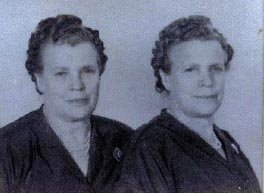
Here's a pic of my twin Grandmothers.
I think Zella's on the left and Stella's on the right? lol I really don't know.
-- Submitted by Larry Wall
 In talking to my mother (Alice Gregory) over the last few days, she tells about "The Palmer House" located on their farm out southwest of Haigler. My dad told her it was a house ordered from the Sears & Roebuck Catalog. A large two story house. My dad was friends with Arch and Beanie Palmer.
In talking to my mother (Alice Gregory) over the last few days, she tells about "The Palmer House" located on their farm out southwest of Haigler. My dad told her it was a house ordered from the Sears & Roebuck Catalog. A large two story house. My dad was friends with Arch and Beanie Palmer.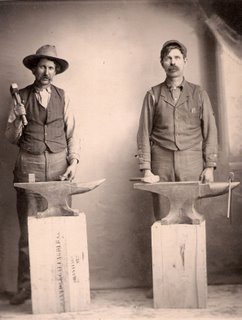 My Great Granddad Samson was a blacksmith. I finally got my hands on a picture of him standing behind an anvil holding a large sledge hammer.
My Great Granddad Samson was a blacksmith. I finally got my hands on a picture of him standing behind an anvil holding a large sledge hammer. She comments on the Montgomery Ward house that was mentioned in the early days of Haigler Blogspot site. She remembers her father, Floyd Trembly, talking about it. It was received at the Haigler Train Depot in crates and assembled on what is now a vacant lot across the street south of the Haigler Elementary School. The scattered remnants of a cement foundation and a depression in the ground are the only evidences of its existance. The site, of course, is now grown over with grass and weeds.
She comments on the Montgomery Ward house that was mentioned in the early days of Haigler Blogspot site. She remembers her father, Floyd Trembly, talking about it. It was received at the Haigler Train Depot in crates and assembled on what is now a vacant lot across the street south of the Haigler Elementary School. The scattered remnants of a cement foundation and a depression in the ground are the only evidences of its existance. The site, of course, is now grown over with grass and weeds. Editor's note: The picture above is an ad for a "Wardway Homes" house taken from a 1925 magazine. It is not necessarily like the one constructed in Haigler. A home like this sold for around $3,000. Other catalog companies like Sears & Roebuck also had Home Kits for sale in their catalogs. These homes were designed to look like the custom built homes of the time, so many of them look like the homes we see around older sections of cities and towns. Here is a link to the Wardway Homes of 1925. One of them is very likely similar to the one built in Haigler.
Editor's note: The picture above is an ad for a "Wardway Homes" house taken from a 1925 magazine. It is not necessarily like the one constructed in Haigler. A home like this sold for around $3,000. Other catalog companies like Sears & Roebuck also had Home Kits for sale in their catalogs. These homes were designed to look like the custom built homes of the time, so many of them look like the homes we see around older sections of cities and towns. Here is a link to the Wardway Homes of 1925. One of them is very likely similar to the one built in Haigler. Larry Wall is my cousin. His father, Max Limon Wall and my mother, Helen Elizabeth Wall-Cross were brother/sister. Stella Wall was their mother. Stella and her sister, Zella, were as identical as they get. Even their own kids could not tell them apart! I could not tell which one was my grandmother when they were together.
Larry Wall is my cousin. His father, Max Limon Wall and my mother, Helen Elizabeth Wall-Cross were brother/sister. Stella Wall was their mother. Stella and her sister, Zella, were as identical as they get. Even their own kids could not tell them apart! I could not tell which one was my grandmother when they were together.
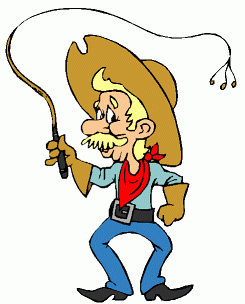 Haigler is a place where the men are men and the women are too!! Hahaha... that was a joke. Just means that the women work just as hard as the men to make things work. None of this "Princess" stuff. People are willing to do whatever it takes to make their lives work.
Haigler is a place where the men are men and the women are too!! Hahaha... that was a joke. Just means that the women work just as hard as the men to make things work. None of this "Princess" stuff. People are willing to do whatever it takes to make their lives work. A must first, the old Victrola record player -- a big box looking thing with a large horn like thing on the top (speaker), with a wind-up handle on the side. YEP!! we were ROCKIN' then!!
A must first, the old Victrola record player -- a big box looking thing with a large horn like thing on the top (speaker), with a wind-up handle on the side. YEP!! we were ROCKIN' then!! listen to Spanish stations. (don't know where they actually originated from) Stuff that sounded like outer space, also. We used to listen to the boxing station and Arthur Godfrey in "Lonely Little Petunia in an Onion Patch" -- Johnny Cash. Then came a few more modern (non-transistor) radios in the cars and at home. "Let's do the Hop", Blue, Blue, Blue Suede Shoes" and others.
listen to Spanish stations. (don't know where they actually originated from) Stuff that sounded like outer space, also. We used to listen to the boxing station and Arthur Godfrey in "Lonely Little Petunia in an Onion Patch" -- Johnny Cash. Then came a few more modern (non-transistor) radios in the cars and at home. "Let's do the Hop", Blue, Blue, Blue Suede Shoes" and others. The CB radio (Citizen Band). Everybody had a handle. I was "Scrooge", and my wife was "Big Spender". hehe!! 10-4, Big Buddy!!.. Over and Out, Copy that!... Received!... Come back. We had a CB in the early 1970's in the motorhome. Channel 19, I think, if you were east and west; Channel 17 if you were north and south. Channel 09 was React (Emergency). The FAA had strict rules, but some guys would power up beyond capacity and reach Alaska on a cloudy day when signals could skip. Yep! It was fun!
The CB radio (Citizen Band). Everybody had a handle. I was "Scrooge", and my wife was "Big Spender". hehe!! 10-4, Big Buddy!!.. Over and Out, Copy that!... Received!... Come back. We had a CB in the early 1970's in the motorhome. Channel 19, I think, if you were east and west; Channel 17 if you were north and south. Channel 09 was React (Emergency). The FAA had strict rules, but some guys would power up beyond capacity and reach Alaska on a cloudy day when signals could skip. Yep! It was fun! Games we played when we were kids:
Games we played when we were kids: We Husker fans amuse ourselves by scaring every Colorado fan we see strutting down the street, with that obnoxious Black & Gold "CU" on their shirt and/or hat. We would swerve our vehicles as if to hit them, and swerve back just missing them.
We Husker fans amuse ourselves by scaring every Colorado fan we see strutting down the street, with that obnoxious Black & Gold "CU" on their shirt and/or hat. We would swerve our vehicles as if to hit them, and swerve back just missing them. Have you noticed the little envelope at the bottom of each post? If you click on it, a little email form will come up. You just fill in your name, email address, their email address and click the send button and a link to the story is sent to your friend.
Have you noticed the little envelope at the bottom of each post? If you click on it, a little email form will come up. You just fill in your name, email address, their email address and click the send button and a link to the story is sent to your friend.

 My Dad, Emmons Adams, joined the Oddfellows Hall in 1929 at the tune of $6.00 to join and annual dues of $10.00. He may have been District Grand Master (DGM81) out of North Platte or District Deputy, I don't know for sure which.
My Dad, Emmons Adams, joined the Oddfellows Hall in 1929 at the tune of $6.00 to join and annual dues of $10.00. He may have been District Grand Master (DGM81) out of North Platte or District Deputy, I don't know for sure which. Larry Wall, a grandson of Bill & Stella Wall, sends pictures that you may recognize.
Larry Wall, a grandson of Bill & Stella Wall, sends pictures that you may recognize.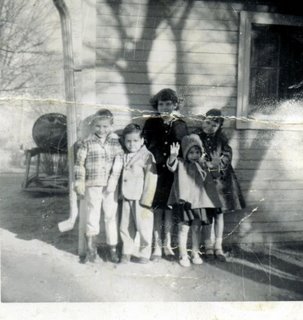

I didn't know much about Haigler from away back, except through other people’s stories. We mostly went to Parks. It was closer and was my parents’ "home town", plus my Aunt Georgia's house was along the road to Parks.
I remember White's house when it was Boyd's house. Grandma Boyd was a tiny little woman. Her son, George, who was single, lived with her and did the farming. Their first house was on the south side of the road (CR891 /BB) between Uncle Vester Crabtree's house and east of the
My grandparents, Peter and Sarah Crabtree, lived at the Boyd’s first place while they were building a barn and house and dug a well on their own place on the next quarter south. Otherwise they would have had to sleep under their wagons or something I guess. They were lucky that the Boyd's house was right there standing empty. My dad, Frank, was about nine years old, Aunt Cora about 5, Aunt Sarepta , maybe 16. Uncle Vester, about 17, Mary and Addie. The three oldest of the family, Uncles Will, Dave, and Abel were still in Eastern Nebraska.
The first people who rented Gertrude’s place were the Charlie Armstrong family. They moved there sometime during the year when I was in sixth grade (1925) and Mildred and Marjorie came to our school, Prairie Rose for several years. Then the Armstrongs bought the Zuege place and the Alva McDonald's rented it.
To homestead was quite an undertaking. A lot of settlers gave up and left without proving up and another settler would buy it from them or somehow acquire the land and continue building it up.
--Submitted by Alice Gregory
(Editor’s note: When she was a child,
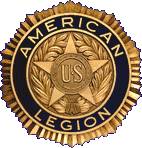 I'm not sure how to write about this subject without documentation, but I will do the best I can from what I don't know!
I'm not sure how to write about this subject without documentation, but I will do the best I can from what I don't know! Stay with this -- the answer is at the end. It will blow you away.
Stay with this -- the answer is at the end. It will blow you away.
This man would be only 59 years old

 Back of Program
Back of Program Seniors
Seniors
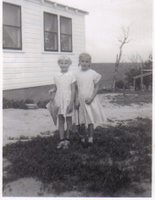
 She sent me two pictures this morning that I have never seen. She found them while looking through some pictures her mother had kept.
She sent me two pictures this morning that I have never seen. She found them while looking through some pictures her mother had kept.Blog is short for weblog. A weblog is a journal (or newsletter) that is frequently updated and intended for general public consumption. Blogs generally represent the personality of the author or the Web site.Another definition:
A blog is a personal diary. A daily pulpit. A collaborative space. A political soapbox. A breaking-news outlet. A collection of links. Your own private thoughts. Memos to the world.
Your blog is whatever you want it to be. There are millions of them, in all shapes and sizes, and there are no real rules.
In simple terms, a blog is a web site, where you write stuff on an ongoing basis. New stuff shows up at the top, so your visitors can read what's new. Then they comment on it or link to it or email you. Or not.
Since Blogger was launched, almost five years ago, blogs have reshaped the web, impacted politics, shaken up journalism, and enabled millions of people to have a voice and connect with others.
 One day, after my sister Leone got married, Mary invited her and Leah to learn how to make those rolls that we call "Mary Smith Rolls" to this day!
One day, after my sister Leone got married, Mary invited her and Leah to learn how to make those rolls that we call "Mary Smith Rolls" to this day!  One of the things I remember about going to their house was that in the winter their ponds would freeze solid and they would invite us to come and go ice skating. They would set up a bonfire and we would roast hot dogs and marshmellows. They must have had several pair of clip on ice skate that we would clip onto our shoes and take off across the pond.
One of the things I remember about going to their house was that in the winter their ponds would freeze solid and they would invite us to come and go ice skating. They would set up a bonfire and we would roast hot dogs and marshmellows. They must have had several pair of clip on ice skate that we would clip onto our shoes and take off across the pond. Dave (Samual David) and Mollie (Mary Frances Samson) Gregory were married in Haigler, Nebraska on July 4, 1907. They first lived on a farm north of Haigler that they called the Aultman Place, but later took up residency in a house on south King Avenue.
Dave (Samual David) and Mollie (Mary Frances Samson) Gregory were married in Haigler, Nebraska on July 4, 1907. They first lived on a farm north of Haigler that they called the Aultman Place, but later took up residency in a house on south King Avenue. Dave owned a team of horses and a dray wagon that he used to haul anything people wanted moved from one place to another.
Dave owned a team of horses and a dray wagon that he used to haul anything people wanted moved from one place to another.

My dad tells a story about when they moved from Oxford to Haigler, they loaded all their posessions on a Model A Ford. Things were tied on top and hanging from the sides and bumpers of this car. He remembers moving into a house that sat on the corner of where Hiway 27 now hooks into Hiway 34, just north of the house "Buck" Ryan grew up in. The last I looked, there is still remenants of a foundation in that location.
 George Bartlett homesteaded land south of Parks in what is now known as and marked on the maps as Bartlett Canyon.
George Bartlett homesteaded land south of Parks in what is now known as and marked on the maps as Bartlett Canyon.
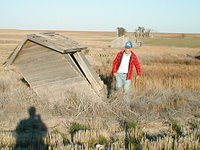 In the scheme of things, the modern indoor bathroom is fairly recent. When I was a kid, the outhouse was located about 100 feet from the house beside the sidewalk that went out to the south fence. It sat beside the "coal house" where coal and cobs were stored to be burned in the pot bellied stove that sat in our living/dining room.
In the scheme of things, the modern indoor bathroom is fairly recent. When I was a kid, the outhouse was located about 100 feet from the house beside the sidewalk that went out to the south fence. It sat beside the "coal house" where coal and cobs were stored to be burned in the pot bellied stove that sat in our living/dining room.
"In 1874, two ranchmen from the forks of the Republican, forty miles west, came into town. they had been living in a tent and one had been bitten by a skunk while he slept. He died the next day, of hydrophobia and Culbertson started its cemetery with him. The next burials were the Kansas horse thieves, Stewart and Randall, cornered and killed in Masacre Canyon by a cowboy crew led by Steve Bolles and the Doyle brothers. The next death was that of a respectable citizen, whose family would not bury him beside the other three, making it necessary to start another cemetery in a different place."-- The Call of the Range, by Nellie Snyder Yost
 Looking at a couple of blog entries reminded me; Are the magpies, bluejays, bob whites, quail, prairie chickens, pheasants and pigeons still plentiful in the area? The last few times I have been back, I have seen wild turkeys -- as many as 30 in a flock, but don't remember the other birds!??
Looking at a couple of blog entries reminded me; Are the magpies, bluejays, bob whites, quail, prairie chickens, pheasants and pigeons still plentiful in the area? The last few times I have been back, I have seen wild turkeys -- as many as 30 in a flock, but don't remember the other birds!?? DDT, the chemical, almost wiped out the eagles and osprey here in Washington and the west coast. It was banned way back when?? 50's?
DDT, the chemical, almost wiped out the eagles and osprey here in Washington and the west coast. It was banned way back when?? 50's?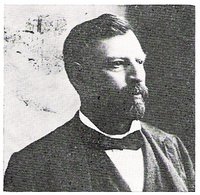 ...Tom Wray, for whom the town of Wray, Colorado was named, brought cattle to south west Nebraska in 1876...
...Tom Wray, for whom the town of Wray, Colorado was named, brought cattle to south west Nebraska in 1876...Woods and the Kearney county sheriff then hurried to the Prairie Home restaurant, where the outlaws were seated at a table in the back of the room, their guns in their laps. Woods went in the front door and covered Belmont, the most dangerous of the two. The other sheriff, supposed to enter from the back and cover Zimmerman, lost his nerve and dived down a handy cellar stairway instead.
The outlaws, too quick for Woods alone, shot him down before he could fire. Then gunning down two innocent bystanders, R. B. Kelly and Charles Collins, who tried to run out of the restaurant, they jumped on their horses and headed for Kansas. At a ranch many miles to the south, they ate supper the next evening and went to bed - but got up and left in the night, riding the two best horses on the place.
A ranch hand, owner of one of the horses, and his sweetheart, the hired girl, tracked the rustlers to an old abandoned house and hid in some brush near the buildings. When Belmont sauntered out the next morning, the cowhand shot him down. Zimmerman came out next, his hands up and surrendered.
The Wray horses, returned to their owner, were afterward known as "the Belmont mares."
-- The Call of the Range, by Nellie Snyder Yost, p. 271, 272
 Well the father"s name was also Arch. But he didn't fly any plane. He walked and walked. He was an expert card player--I don't remember what kind of game. But he would take off walking to other towns to play. He would just leave without notice and be gone a few days or weeks or months.
Well the father"s name was also Arch. But he didn't fly any plane. He walked and walked. He was an expert card player--I don't remember what kind of game. But he would take off walking to other towns to play. He would just leave without notice and be gone a few days or weeks or months.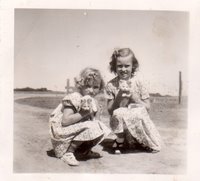 Farmers always have a lot of pets We had the usual dogs and cats (once, I think we counted 13 cats) The first dog I remember was "Penny". She was a copper-colored terrier (hence, the name Penny) and met her doom during an encounter with a cement truck.
Farmers always have a lot of pets We had the usual dogs and cats (once, I think we counted 13 cats) The first dog I remember was "Penny". She was a copper-colored terrier (hence, the name Penny) and met her doom during an encounter with a cement truck. When our little sister, Eunice was small, We had a large, white German Shepherd named Gilda; and a small, black pekingese mix named Nipper. They were very competitive for affection, and whenever we gave Gilda something to eat that she didn't particularly want, all we had to say was "here Nipper", and Gilda would gobble down the food.
When our little sister, Eunice was small, We had a large, white German Shepherd named Gilda; and a small, black pekingese mix named Nipper. They were very competitive for affection, and whenever we gave Gilda something to eat that she didn't particularly want, all we had to say was "here Nipper", and Gilda would gobble down the food.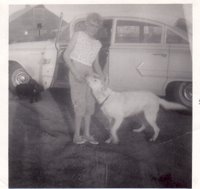 Gilda wasn't a very friendly dog, especially after she had a large family. We were considering "sending her away", until one day she killed a rattlesnake right outside our front door where Eunice was playing. Gilda was bitten by the snake but survived; and after that, Mamma decided that she was a GOOD dog!
Gilda wasn't a very friendly dog, especially after she had a large family. We were considering "sending her away", until one day she killed a rattlesnake right outside our front door where Eunice was playing. Gilda was bitten by the snake but survived; and after that, Mamma decided that she was a GOOD dog! Even the wild animals couldn't escape. We had a pet pigeon named Rajah, whose wings we clipped so he couldn't fly away. Rajah would ride behind us on the bicycle.
Even the wild animals couldn't escape. We had a pet pigeon named Rajah, whose wings we clipped so he couldn't fly away. Rajah would ride behind us on the bicycle.  And the snakes couldn't escape us, either.. We had great fun in the haymow, poking around at the bullsnakes and making them hiss at us. We were just lucky that some of those bullsnakes didn't turn out to be rattlesnakes!
And the snakes couldn't escape us, either.. We had great fun in the haymow, poking around at the bullsnakes and making them hiss at us. We were just lucky that some of those bullsnakes didn't turn out to be rattlesnakes!